Spirit photography has been at the heart of paranormal research for centuries. Guest writer PETER TOWNSEND delves into the history of taking photos of ghosts!
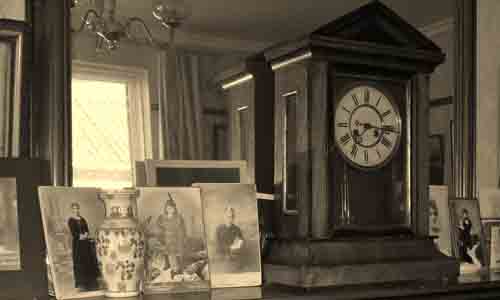
The Birth of Spirit Photography
In the Victorian era photographing ghosts came to be known as spirit photography. Today, ghostly anomalies on photographs generate lively debate on the internet. Some people assert that these haunting images are authentic paranormal evidence of the return of the dead. In contrast, others will claim that they are merely random images, or even worse, crude and unconvincing fakes.
There is nothing new about this debate. In Victorian times there were a number of spirit photographers on both sides of the Atlantic claiming to have proof of ghosts of dead family members and friends reappearing on the photographs they had taken. Sceptics begged to differ, usually pointing their finger to fraud being involved.
An early pioneer of spirit photography was Boston engraver and keen amateur photographer William Mumler. When taking his self-portrait in 1861 he was stunned to see a strange face next to his on the developed plate. Mumler claimed it was the image of a cousin who had died some years earlier. He went on to build up a profitable trade as a spirit photographer. Critics claimed that the images were the result of double exposure techniques. His lucrative trade suffered, when allegations surfaced suggesting that a number of the ghostly images were in fact living Boston individuals.
As a response to this crisis Mumler decided to move his business to New York. Business was brisk, but it wasn’t long before he encountered problems. One of the influential men in New York, was the Supreme Court Judge, John Edmonds. He visited his studio, apparently convinced that Mumler was a fraud. However, he left the studio with the firm belief that these were genuine spirit photographs. Mumler was charged with fraud and brought to trial in 1868. The testimony of Judge John Edmonds could well have been one factor in ensuring that a not guilty verdict was reached.
Mumler paved the way for a long line of successors, both in the USA and UK. Ghostly photographs gained popularity, and this also fuelled the remarkable growth of the Spiritualist church.
In England, in the 1870s, there were a number of people engaged in spirit photography. One such person was Frederick Hudson, who worked closely with the medium Mrs Guppy. Critical voices within Spiritualism thought Hudson had prepared his plates in advance, or double-printed two negative plates into one print.
Some even suggested that he had accomplices dressed up as ghosts. Problems came to a head after an article in the Spiritualist magazine on September 1872. It claimed that a number of plates revealed signs of double exposure. In one example given, it was said that the pattern of a background carpet was seen through the dress of a woman having her photograph taken.
Nevertheless, Hudson and fellow spirit photographers had a loyal band of followers. Many Spiritualists and other supporters took great comfort in photography as reliable evidence of the spirit world. This was summed up by Rev. H. R. Haweis when he stated: “Photograph me a ghost: chemicals have no fancies, plates don’t get nervous, and lenses tell no lies!”
Heavyweight support for spirit photography came from Sir William Crookes and Alfred Russell Wallace. Crookes, a noted chemist and physicist, studied spirit photography for many years and broadly believed in its authenticity. Wallace, eminent as the co-developer of the theory of evolution, believed spirit photography merited serious scientific study.
The Lord Combermere photograph, first taken in 1891 and later published in 1895, proved to be a sensation. Sybell Corbet took a very lengthy exposure of the Combermere Abbey library, when no one else but her was present. The figure of a man can be seen sitting in one of the chairs, believed to be the ghost of Lord Combermere. At the time Corbet was taking the photograph Combermere’s funeral was taking place a few miles away.
Sceptics would point out that a semi-transparent image could easily have appeared with a lengthy exposure – particularly if a servant had entered the room and sat in the chair for a fleeting moment. However, it was claimed that all servants and members of the household were attending the funeral at the relevant time.
The second article on spirit photography will follow the turbulent fortunes of spirit photography after World War 1. During this period famous figures such as Sir Arthur Conan Doyle and Harry Houdini clashed on the practice of spirit photography. Conan Doyle is world famous as the creator of Sherlock Holmes, but some readers today might be surprised to learn what his views were on spirit photography…and also on fairies!
Spirit Photography after the Great War
In the early period of the twentieth century the death and carnage of World War I had given a boost to the fortunes of spirit photography. James Coates Photographing the Invisible, first published in 1911, had also brought spirit photography to the attention of a much wider audience.
However, controversy was never far away. Photographs taken at séances revealed ectoplasm streaming from the mouths of the medium. In reality, this was shown to be nothing more than ordinary cheesecloth, perhaps coated with a glowing paint. Spirit mediums could exploit a pulley or string to drop the ectoplasm down from the ceiling at the key moment in the séance. It could then be easily pulled away when required making it difficult to detect.
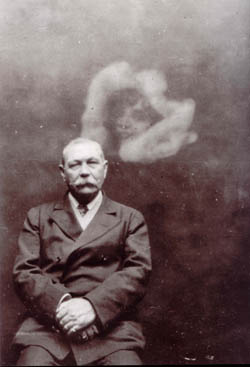
In 1924 Ada Emma Deane, a former cleaning lady from London, was accused by The Daily Sketch of using the images of thirteen footballand boxing personalities, all very much alive, as the ghosts of dead soldiers at an Armistice Day ceremony. Deane was defended by Conan Doyle, who was a formidable advocate of both Spiritualism, and spirit photography.
Conan Doyle was surprisingly uncritical of photographic evidence, whether it was spirit photography, or in one celebrated case, images of fairies. Two young girls, Elsie Wright and her cousin Frances Griffiths, claimed to have seen fairies in Cottingley Glen, Yorkshire. They took photographs of them playing with the fairies. This discovery produced a sensation back in 1917. Conan Doyle, and a great many others, believed in the authenticity of the photographs. Later, Conan Doyle wrote a book, The Coming of the Fairies. However, in 1981 Frances Griffiths admitted that the photographs were merely paper cut outs from a very popular children’s book at that time, Princess Mary’s Gift Book.
William Hope headed the Crewe Circle in the 1920s. In striving to be free of fraud and avoid the allegations of fraud that had been levied against Deane and others they invited sceptics to examine their equipment. They even went as far as allowing sitters to bring their own plates, but only if submitted to them days in advance so that they could be ‘magnetised.’
Harry Houdini was a supremely accomplished magician and escapologist as well as a determined debunker of fraudulent spiritualists and photographers. In his book, A Magician Among the Spirits, he outlines the various tricks that mediums and spirit photographers would employ. His debunking in public of mediums and spirit photographers soured his friendship with Conan Doyle.
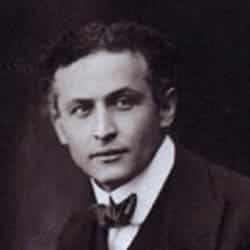
It might seem odd that the creator of Sherlock Holmes, the detective with a razor-sharp logical mind, would have embraced psychic phenomena so unreservedly. This might be attributed in part to the influence of his wife, together with his burning desire to make sense of the tragic loss of his son and brother as a result of injuries in the war. His beliefs, no doubt offered him the reassurance of an afterlife for those he had loved and lost. The lectures, together with lantern slides that he gave, spread this message of hope and comfort to the far reaches of the globe.
A friend of Houdini’s asserted that the Crewe Circle used sleight-of-hand to switch the plates while passing around hymn books. The Society for Physical Research conducted an investigation, and sent Harry Price to see if there was any evidence of trickery. He had an understanding of conjuring and claimed that marked plates had been switched. Spiritualists accused Price of trying to discredit them and switching the plates himself. Doyle strongly attacked both Price and his methods. This was also instrumental in Doyle writing a book The Case for Spirit Photography.
One of the most celebrated ghost photographs was taken in 1936 at Raynham Hall, Norfolk. There was said to be a ghost of Dorothy Walpole. The first sighting of her ghost was in 1835 by a guest at the manor. The guest claimed to see an apparition wearing a brown satin dress and that her eyes that had been gouged out. In 1936, Captain Provand and Indre Shira were taking photographs of the manor for a magazine when Shira reportedly saw the ghost on a staircase. Provand quickly took a photograph. Critics would claim it to be two photographs that had been superimposed on one another.
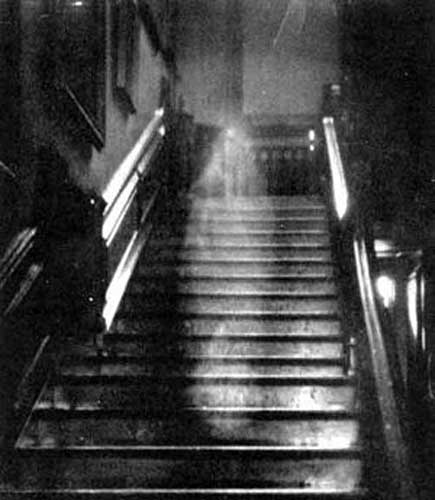
The highpoint of spirit photography was from the 1860s up to the 1930s. After the 1930s, except in the more enthusiastic Spiritualist circles, the interest in spirit photography began to ebb away.
Spirit Photography and the Internet Age
The highpoint of spirit photography was from the 1860s up to the 1930s. After the 1930s the interest in spirit photography began to dissipate, except in the more enthusiastic Spiritualist circles.
Dr Eric Dingwall, a researcher for the Society for Psychical Research, spent the best part of a lifetime examining spirit photographs, only to finally conclude that they were nothing more than fakes. For Dingwall the photographs failed to reveal the return of spirits. Instead, what the photographs did reveal was human folly.
However, in recent years a less dismissive view is taken of spirit photography. Speaking of these photographs Jolly states: ‘They now speak to us more strongly of faith, desire, loss and love, than gullibility.’ Jolly explores how these haunting images have undergone a rekindling of interest in contemporary culture, saying that ‘historians of cinema, photography and visual culture have begun to pay attention to spirit photography and to treat it as an important part of the experience of modernity.’
The internet and digital photography reflect this rekindling of the interest in ghost study and spirit photography. Old and new images appear on the internet, in apparently ever increasing numbers. Ghost societies and television shows exploring the paranormal proliferate. In the spooked media landscape films and television shows feed into the thirst for entertainment, from both believers and sceptics alike.
Strange anomalies on photographs still generate considerable popular interest. Tantallon Castle in North Berwick, dates back to the 14th Century. Christopher Aitchison took a photograph there in May 2008. It appeared to show a woman in period clothes looking out of a window. Aitchison said he did not see anyone at the window at the time he took the photograph, and it was only later when he discovered the anomaly.
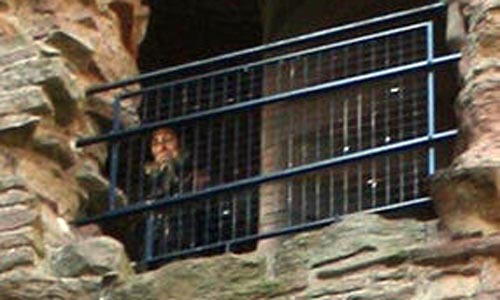
The image, of course, could have a perfectly logical explanation. For example, it could have been a tourist. Or, it might have been a simulacrum. However, staff at the castle asserted that there were no period costumes or historical re-enactments on the day the photograph was taken. Some photographic experts, including those with expertise in Photoshop, could find no evidence of digital trickery.
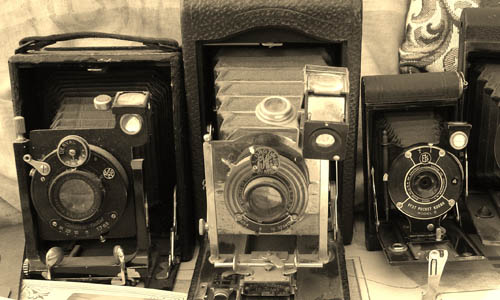
Spirit photography has been a curious marriage between photography and the occult. Its ardent supporters and their belief in the paranormal have met formidable challenges from defenders of rationalism. Even in the age of digital photography, where images can easily be manipulated on a computer, the interest in spirit photography has not been eclipsed. As Cheroux and Fischer state, “The fact that those images of ghosts, spirits, and séances continue to fascinate viewers today is a testament to human curiosity and the continuing allure of the unknown.”
The American Museum of Photography – Do You Believe? Science vs. Séance has a collection of Victorian ghost photographs, many of which were taken in the UK. It states: “Many of the images presented here have been studied and debated for nearly a century. Whether they are ludicrous or miraculous is in the eye of the beholder.”
Readers might like to look at these photographs and form their own view. Are they ludicrous or miraculous? Why do they continue to fascinate viewers today?
PETER TOWNSEND has written a novel about Victorian spirit photography, titled Ghostly Images. Peter was born in Sheffield and has a variety of interests including history, music and art. One of his current fascinations is the history of Victorian England. he now lives by the north-east coast of England and regularly walks on the local beach or on the cliff top path towards Whitby where Ghostly Images is set. The book is available from Amazon here.


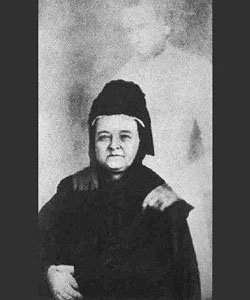
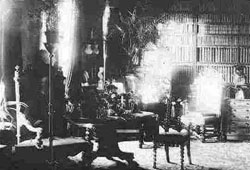
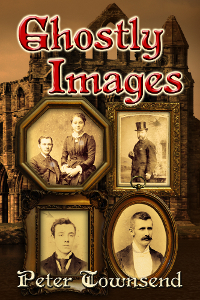




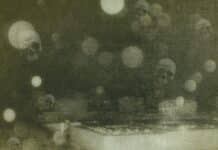
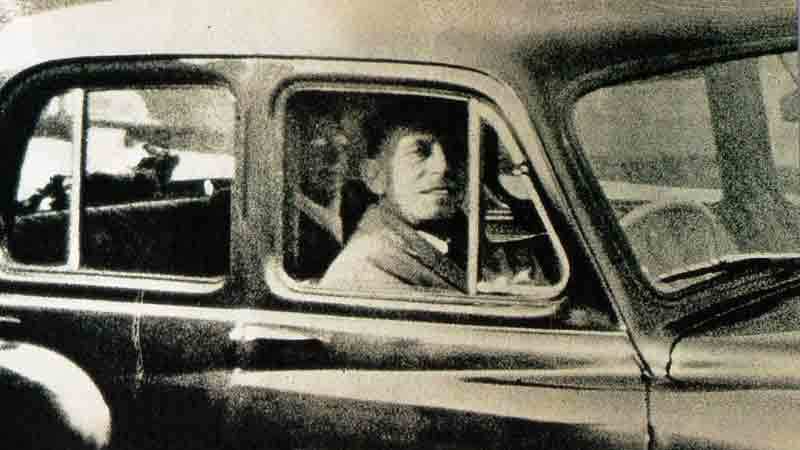
One of my all-time favorite spooky topics. The Metropolitan Museun of Art in New York had an exhibit a few years ago with some of the best from Europe and the States!
Thanks for the information. The American Museum of Photography also has an interesting collection of Victorian spirit photographs. I will be making a reference to this museum in my third article in the series.
Fabulous!